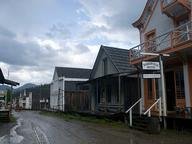Quiz Answer Key and Fun Facts
1. During the 1899 gold rush in Alaska, it was much easier to find the gold in comparison to previous North American gold rushes.
2. Around what peninsula in Alaska, named for an important politician, was the 1899 gold rush centered? It continued there until 1909.
3. Who is credited with finding gold in Alaska in September 1898?
4. Many of the miners who traveled to Alaska in 1899 made their way from which nearby gold field?
5. Near which modern-day Alaskan city did the 1899 gold rush take place?
6. Which of the following politicians gained notoriety during the 1899 gold rush in Alaska for his attempts at claim jumping?
7. During which time of the year was it possible to mine gold during the 1899 gold rush in Alaska?
8. At the beginning of the 1899 gold rush in Alaska, what was the typical method used to extract the gold?
9. What was the biggest geological issue that prospectors had to face while looking for gold in the 1899 Alaska gold rush?
10. What was the most difficult problem that was faced by people coming into the Alaskan gold fields during the gold rush of 1899?
Source: Author
ponycargirl
This quiz was reviewed by FunTrivia editor
gtho4 before going online.
Any errors found in FunTrivia content are routinely corrected through our feedback system.
